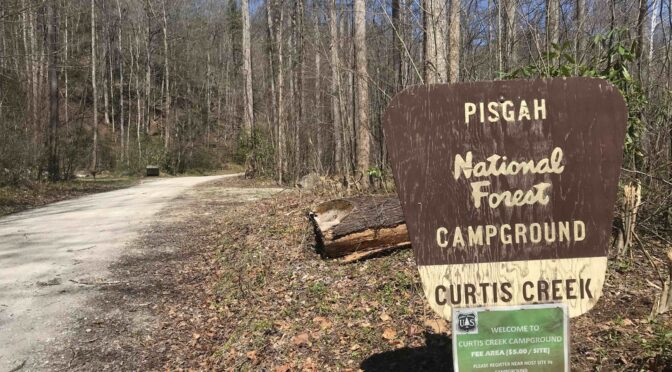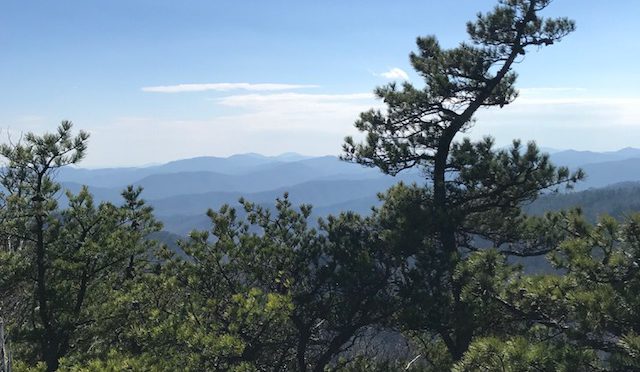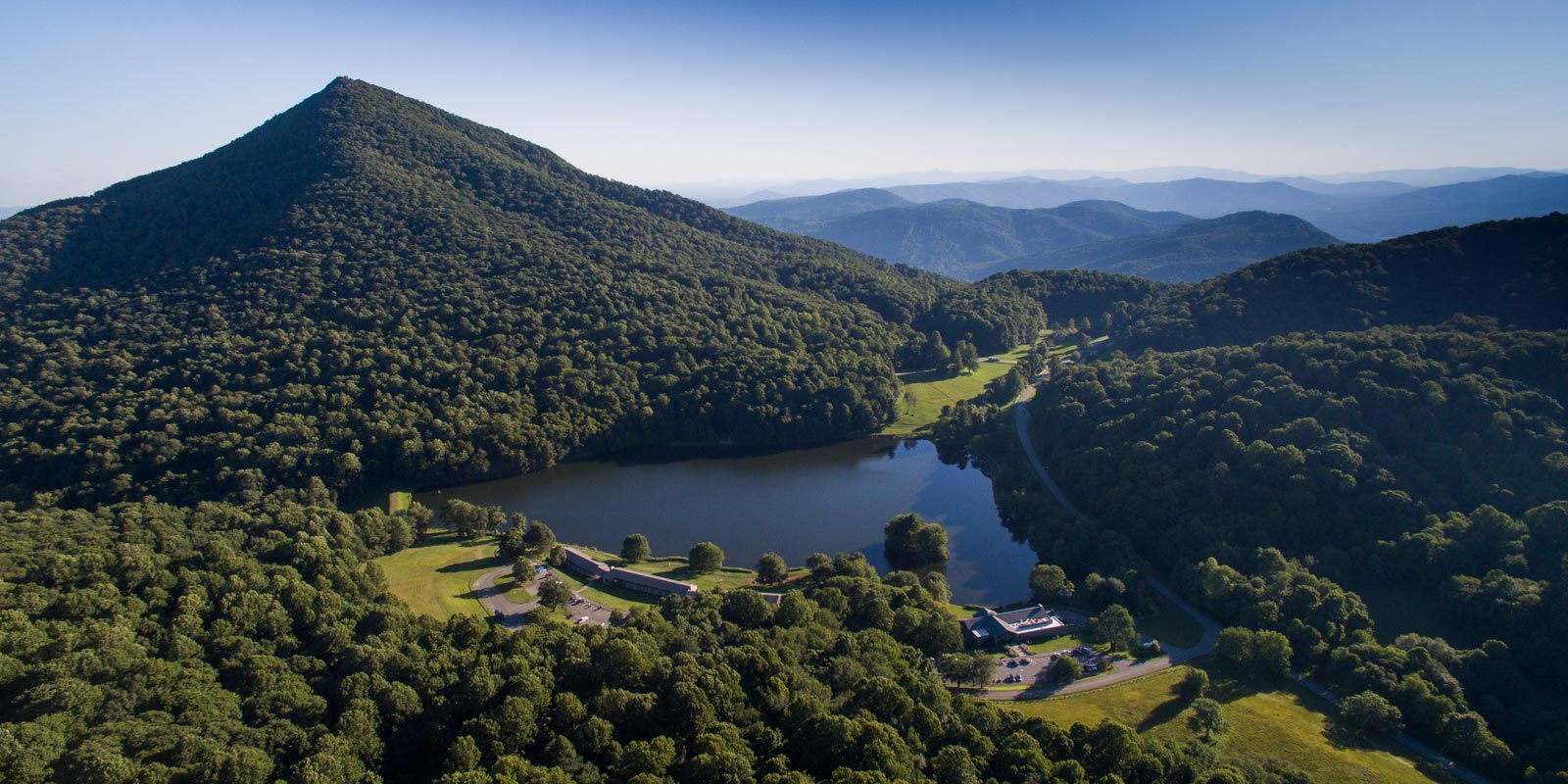We revisit this blog from a couple years back because it’s especially appropriate today, now that gathering in groups, outside, is a thing again. And frankly, gathering 20, 25 good friends for a weekend of camping and hiking is one of the best ways to reunite that we can think of.
Tag Archives: Curtis Creek
Our 5 favorite group campgrounds in North Carolina
We take a lot of groups on weekend hiking trips to the mountains. As a result, we stay in a lot of group campgrounds. When we book a group campground, we look at a number of factors, including:
- Proximity to good hiking. Ideally, we look for a campground with immediate access to trails — and not just any old trails, but trails that will yield a full day of memorable hiking. If we can treat people to an entire day of using just their own feet to get around, we we find they enjoy the day that much more..
- Shaded camping. We hike mostly in summer, so we need to pitch tents where they won’t broil during the day.
- A commons area. A big fire pit, a picnic table or two, rocks or logs to sit on — we don’t ask much, but these are biggies.
- Basic amenities. We need water at the campsite, we’d like a privy not too far away. A bathhouse, of course, is nice. And if we can park a reasonable distance away — within 50 yards of the campsite, say — all the better.
- Privacy. From others in the group, to some degree (hey, we all need a little me time), but mostly from neighboring campers. We escape to the wild for various reasons; it’s those who escape to the wild to be wild that we prefer to avoid.
- Good vibe. Most importantly, the site must have a good vibe. It needn’t be immaculately groomed; rather, we like a spot that fits in with the natural surroundings. Sometimes you know the second you drive up, sometimes it takes a night or two of camaraderie to summons the vibe.
There are other factors, but these are the basics. Based on these basics, here are our our five favorite group campgrounds in North Carolina.
Finding new places for you to explore
It’s one of our favorite things to hear, because it means we’re meeting one of our key goals: leading you into the unknown. Sure, we hike a lot of trails more than once, and for good reason: they’re worth it. Our Charlotte group goes to South Mountains State Park regularly, our Charlottesville crew loves the Jones Run/Doyles River Circuit in the Shenandoah National Park. And with 120 miles of the Mountains-to-Sea Trail running through the Triangle, I’ve lead a goodly number of hikes on the statewide path along the Eno River and the south shore of Falls Lake.
But it’s the new discoveries most hikers really love.
“Show of hands,” I said at the beginning of a recent hike at the Shallow Ford Natural Area north of Burlington: “How many of you have hiked here before?”
None of the eight hikers raised a hand.
Ditto a recent after-work hike at the two-year-old Brumley Nature Preserve in Chapel Hill, at Little River Regional Park on the Durham/Orange county line, and on the Great Blue Heron Loop Trail at Haw River State Park’s Iron Ore Belt Access area. Some of these gems are new, some simply off the beaten path. We’re constantly on the lookout for both.
This week, we thought we would highlight a few upcoming adventures to places that may be new to you.
-
Confluence Natural Area, day hike, Hillsborough, July 22. The Eno River Association is one of those land trusts whose work frequently flies under the radar. If you’ve hiked in Eno River State Park, or at Little River Regional Park, you’ve likely hiked on land preserved by the ERA. They typically buy land in the Eno watershed, then, eventually, turn it over to North Carolina State Parks. This spring, though, the ERA opened the 200-acre Confluence Natural Area, its first preserve open to the public, where we’ll explore 2-miles of newly blazed trail.
- Standing Indian Recreation Area, hiking/camping weekend, Nantahala National Forest, Aug. 24-26. Standing Indian was new to me when I scouted it in 2009. I was finalizing which trips to include in my book “Backpacking North Carolina” and noticed this big network of trails west of Franklin. It seemed worth a chance — and it was. On this trip, the main hike is an 11-mile loop consisting of a mellow climb up Kimsey Creek to the Appalachian Trail at Deep Gap, then hiking north to 5,498-foot Standing Indian and back to camp on the Lower Ridge Trail. We’ll do a shorter hike Sunday.
- Curtis Creek, hiking/camping weekend, Pisgah National Forest, Sept. 28-30. The Curtis Creek area of the Pisgah outside Old Fort is hardly new: in fact, it’s the oldest tract in the Pisgah National Forest, dating back more than a century. It’s also not new in that it’s home to some of the oldest old growth in the Pisgah. We’ll explore here and in the nearby Montreat Wilderness area with a climb up 5,592-foot Graybeard Mountain.
- Joyce Kilmer-Slickrock/Citico Creek Wilderness, four-day backpack trip, Nantahala and Cherokee National Forests, Oct. 25-29. This is the mountain land that time forgot. Too rugged and remote to draw much interest from logging concerns, the area was a natural for inclusion as a designated Wilderness Area. The area may be popular with locals — what locals there are — but it’s largely untouched by us outsiders.
- Nags Head Woods Preserve, hiking/camping weekend, Outer Banks, Nov. 2-4. Usually, when you head to the Outer Banks, your thoughts are on the beach, not the trail. Yet there’s some stunning hiking to be done, none more so than through the maritime forest at The Nature Conservancy’s thousand-acre Nags Head Woods Preserve. Five miles of trail explores everything from dense woods to the sound. That’s Saturday; on Sunday, we’ll do another five miles amid some of the oldest trees in North Carolina, in Pettigrew State Park.
Interested in expanding your adventure horizons? Find more information on each adventure in the links below and join us.
Happy trails,
Joe
Explore!
Learn more about the new places we’ll be exploring by clicking on the links below.
Confluence Natural Area
Standing Indian
Curtis Creek
Joyce Kilmer-Slicrock/Citico Creek Wilderness
Nags Head Woods
So many adventures, so few weekends
So many adventures, so few weekends.
That’s the story of summer, the 13-week run between Memorial Day and Labor Day when we pack in most of our adventures for the year. So we set out to pick some destinations that seem most worthy of summer fun. Here are a few places we’re headed this summer, and why:
Peaks of Otter
Blue Ridge Parkway in Virginia
June 1-3
Adventure: Weekend basecamp hiking
This especially adventurous trip combines hiking with a bit of history and a farm trip. June 6 marks the 74th anniversary of D-Day, and we’ll piggyback this hike with a visit to the National D-Day memorial in nearby Bedford, Va. After a tour of the museum Friday afternoon, we’ll continue on to our weekend basecamp at the Peaks of Otter campground. Saturday, we’ll hike three trails — 4.4-mile Flat Top, 3.3-mile Harkening Hill and 1.5-mile Sharp Top — and on Sunday we’ll make a return trip up Sharp Top to take in the sunrise. On the way out, we’ll stop at A Goode View Alpaca Farm.
Linville Gorge
Linville, NC
June 22-24
Adventure: Weekend basecamp hiking
Linville Gorge is one of the Southeast most iconic adventures. The Linville River drops 2,000 vertical feet on its 13-mile run through a gorge that’s 1,300 feet deep, creating some dizzying drops and heart-pounding climbs. The majority of the region is a designated wilderness, so you get little help in finding your way: no trail blazes and when a towering hemlock drops, no one moves in with a chainsaw to chisel a way through. It’s some of the best true exploring to be had in these parts. We stick to the east rim Saturday, hiking from Table Rock to Shortoff Mountain and back, then Sunday plunge into the gorge on trails out of the Visitor Center.
Wilson Creek
Pisgah National Forest near Mortimer, NC
June 29-July 1
Adventure: Backpacking Solo
For a summer destination, it’s hard to beat Wilson Creek, which serves as the drainage for massive Grandfather Mountain. Water worms its way every which way here, making for refreshing stream crossings, lots of waterfalls and delightful pools to cool off in. Wilson Creek itself can be overrun on a hot summer’s day, so we plan to hit the less popular, more challenging Gragg Prong and Lost Cove portions of this wild area on a trip that includes camping solo on a ridge ending in one of the best outcrop overlooks around; it’s an ideal locale for coffee and a Sunday brunch of oatmeal and Pop-Tarts. We hike out Sunday morning, with the option for a hike to South Harper Falls.
Standing Indian
Nantahala National Forest near Franklin
Aug. 24-26
Adventure: Weekend basecamp hiking
We went to Standing Indian two years ago and loved it. From the group campsite we hike up Kimsey Creek to the Appalachian Trail, cross over Standing Indian, and return to camp on Lower Trail Ridge Trail, so we can loll about back at camp in the cool waters of Kimsey Creek. Sunday, we head up Blackwell Ridge to the AT, with a return down the Long Branch Trail, in an area of old growth woods. It’s the perfect summer send-off.
Curtis Creek
Pisgah National Forest near Old Fort, NC
TBD
Adventure: Weekend basecamp hiking
NOTE: This was actually going to be a sneak into summer this coming weekend, but a stormy forecast has pushed this trip to another weekend. We’ll let you know the new date! Curtis Creek became part of the nation’s nascent national forest system in 1913, becoming the first land in North Carolina’s Pisgah National Forest. The area is so rugged that large swaths of land hadn’t been logged yet and weren’t likely to be. Our base for the weekend is the Curtis Creek Campground up the gravel Curtis Creek Road. Both of our hikes emanate from the campground: on Saturday, we’ll take the Snooks Nose Trail 4.1 miles up to the Green Knob observation tower, encountering old growth woods above 3,200 feet. A little off-trail hiking will be required to reach the most impressive stands of poplars in an area off Laurel Knob called the Pompous Bowl. Sunday, after a pancake breakfast, we take a shorter hike out of the campground up Hickory Branch to more old growth.
Join us!
Learn how you can join us on these summer adventures by clicking on the links below.
Happy trails!
Joe
Experience Old Growth Forest in a New Light
But just across Little Santeetlah Creek— outside the memorial forest but within the Joyce Kilmer-Slickrock Wilderness— hikers can find true wonders. From the shared parking area, follow the Naked Ground Trail up Little Santeetlah, through a long draw that culminates in something approaching a box canyon. Along the way, you may glance up on occasion to take in these more subdued hardwoods and then — Whoa! look at the size of that tree! For whatever reason, the Babcock Lumber Company working the area a century back missed a few prime specimens: some giants are more than 100 feet high and more than 20 feet around. Occasionally, you’ll see a handful in close proximity. It’s a fine reward for a walk in the woods.
Below, you’ll find some of the remaining stands of old growth forest in North Carolina and Virginia. Additional information on exploring each area can be found below.
North Carolina
Nantahala National Forest
Hickory Branch Trail
According to the Southern Appalachian Forest Coalition, there was no logging here above 3,680 feet, leaving impressive montane-oak hickory and high elevation red oak forests. Protected as “Large Parch Old-Growth” by the Nantahala National Forest, trees here date back more than 200 years.
Pettigrew State Park (coast)
Moccasin Trail
Head down the Moccasin Trail from the park office and you’ll quickly be surrounded by some of the largest existing trees of their kind. Bay trees, sweet gums, persimmons and pawpaws all reach heights you’ve not seen before; bald cypress with trunks 10 feet in diameter and poplars reaching 130 feet are not uncommon, as are 100-foot-high Atlantic white cedars.
Pisgah National Forest
Snook’s Nose Trail
This trail begins below 1,800 feet in elevation, and within a mile and a half reaches the 3,200-foot mark, above which no logging took place (overall elevation gain on this 3.9-mile trail is just under 3,000 feet). Look for chestnut oak, black gum, red maple, black birch, table mountain pine, and Carolina hemlock, if you can see them through the mountain laurel and rhododendron lining the lower portions of the trail. Find more info on Snook’s Nose and our weekend visit in May below.
Weymouth Woods-Sandhills Nature Preserve (coastal plain)
Weymouth woods loop
There was a time when longleaf pine was the dominant forest in the Southeast. Today, the full majesty of this tree once coveted for its resin and sturdy trunks used as ship masts can only be found in places such as Weymouth Woods, where the longleaf still reaches heights of 100 to 120 feet. The oldest trees — up to 450 years old — can be found on the preserve’s Boyd Tract.
More info here.
Virginia
Jefferson National Forest
Cornelius Creek — Apple Orchard Trail loop
It took a train wreck that bankrupted the local lumber company in 1910 to spare portions of the North Creek watershed from logging. This trail combines with the AT for a 7-mile loop hike.
Jefferson National Forest
Garden Mountain — Appalachian Trail
Garden Mountain is part of the Ridge and Valley Province, and the surrounding forests include old-growth upland oaks. You’ll also get good views from atop Garden Mountain and Chestnut Knob.
* * *
Explore old growth with GetHiking!
On our GetHiking! Classic Escape in May, we will explore old-growth forests in the Pisgah National Forest. On Saturday, May 19, we’ll climb the challenging 3.9-mile trail, going over Snook’s Nose and Laurel Knob, and search for old-growth forests above 3,200 feet. On Sunday, May 20, we’ll explore more old-growth in a shorter hike that’s more off-trail. Both hikes originate from our base camp for the weekend, the Curtis Creek Campground.
Learn more about our May escape and sign up here.
Resources
“Ancient Appalachian: the Southeast’s Old-Growth Forests” appeared in Blue Ridge Outdoors in 2005 and provides a look into the extent and location of old growth forests in the Southeast. Read the story here.
For more on exploring the old growth tracks listed above:
- Hickory Branch Trail
Directions: From the town of Andrews, take Junaluska Road to Junaluska Gap and park. Hike northeast on the Junaluska Gap Trail for a little more than a mile, then head northwest (or go left) on Hickory Branch. (You can return via the London Bald Trail).




